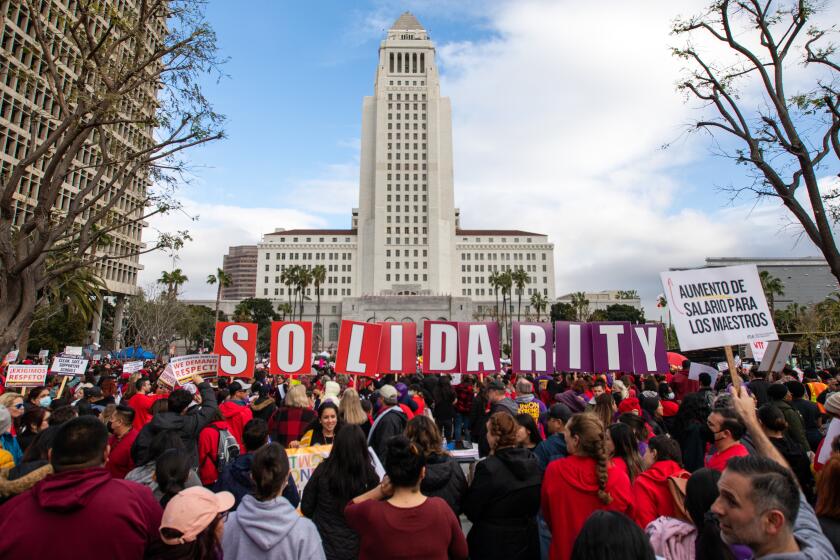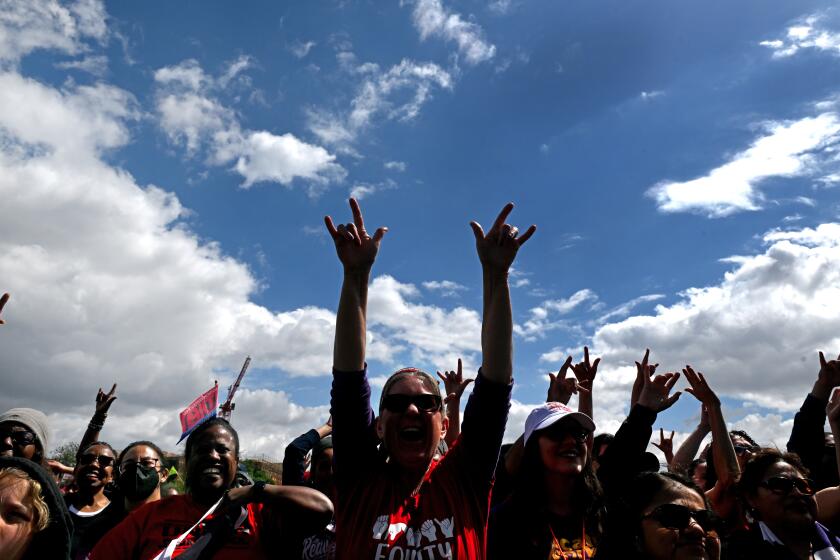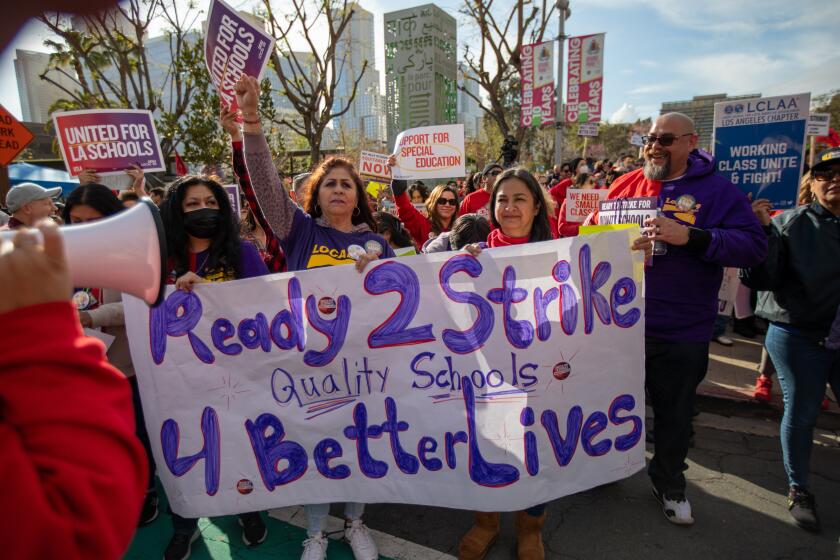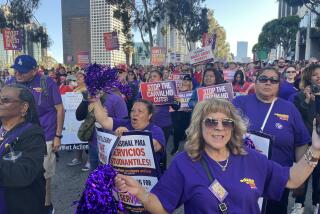A 16-year LAUSD employee pickets over earnings of just $1.41 over minimum wage
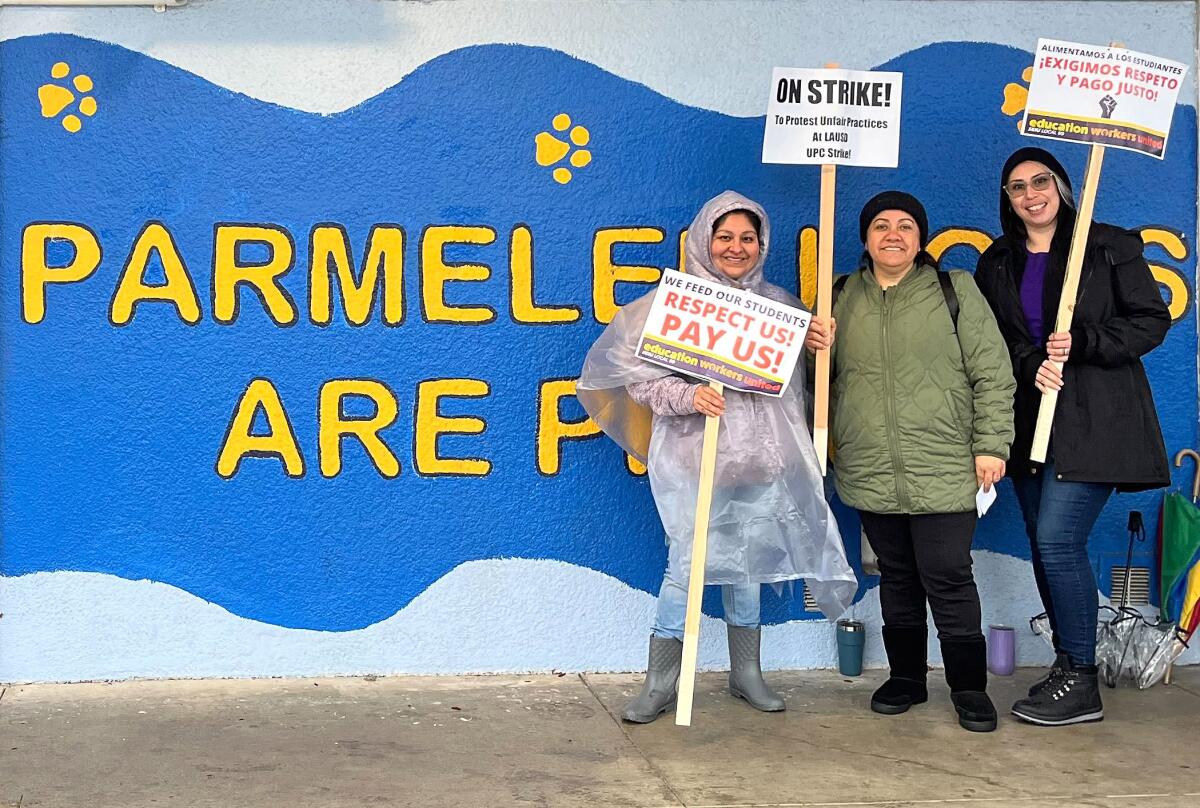
- Share via
At Parmelee Elementary in South L.A., Margarita Gasca bundled up in thick black boots, a heavy coat and a beanie to join the picket line outside the campus and fight for a living wage.
The 48-year-old food service worker has worked at Parmelee for a year and has been with the school district for 16 years. She makes $16.91 an hour and feels like she is “basically working for benefits,” she said.
She said she has not had a raise in about five years.
“They pay us too low for the work that we do,” Gasca said.
The cafeteria is “very short staffed,” she said. She works 6.5 hours a day and would welcome more work — but the district said there are no more hours available, she said, even though the job must get done.
“They say they don’t have enough hours for us. We’ve got to hustle. We’ve got to feed the kids regardless.”
New hires, she said, come in making the same or higher wages than what she makes, even when she trains them.
Los Angeles Unified School District workers walk out in a strike expected to last through Thursday.
Joining her on the line, for instance, was Elina Velasco, 37, a senior food service worker who has worked in the cafeteria for a year and makes $18 an hour.
It’s all too little, they say, for work that is nonstop. They said there are only three workers in the cafeteria — and when someone calls in sick, there are few substitutes.
The women said they prepare about 700 breakfasts — which are placed in bags that students take to class — and about 800 lunches and more than 100 suppers.
They cook — including making hundreds of cookies from scratch — fill the plates, do the dishes, clean the kitchen, take the students’ names and input them in the computer system, serve the meals in line.
For about eight months, one of their two stoves was broken, and a refrigerator finally got long-overdue repairs, they said.
The nation’s second-largest school district ground to a halt Tuesday as 30,000 service employees — joined in sympathy by about 30,000 teachers — walked off the job to begin an anticipated three-day strike in demand of higher wages.
It’s an often invisible role, despite the hard work, because they rarely leave the cafeteria. Case in point: When the women arrived at the protest, a few people asked who they were.
“We’re in the cafeteria. We’re at the bottom of the food chain,” Velasco said.
Still, Velasco said, the support through the strike feels good.
About two dozen employees marched in the rain with them on Tuesday in the Florence-Firestone neighborhood, getting a few honks from passing cars on an otherwise quiet morning. Despite the campus offering child care, only a handful of students arrived.
When striking workers pulled up to the locked employee parking lot, they were greeted by an administrator who told them that if they didn’t work, they couldn’t park there, one striking worker said.
Erika Rioverde, a 39-year-old parent resources liaison at Parmelee Avenue Elementary who makes $15 an hour, came with her 13-year-old son, Christopher Ortiz, since his campus was closed, too. Her 6-year-old son, who attends Parmelee, was with his grandmother. Many strikers had similar struggles to find day care for their own children in the district.
“We’re the parents of the kids we service,” said Rioverde.
What are child-care options when LAUSD schools close for a strike? Some L.A. County parks will be open, along with some city parks and even campuses.
Rioverde schedules classes for parents, helps run English as a second language programs and health classes for parents.
She is also the homelessness liaison at the school, she said.
Rioverde grew up in this neighborhood and has been working on this campus for nine years.
During the pandemic, she worked on campus, not at home. She sat at a table outside, even when it rained, helping parents with remote learning technology and the parent portal.
“I don’t get to go to school,” said Christopher, who attends an LAUSD middle school campus closed during the strike. “My mom needs to make more money. She goes to union meetings all the time. She comes to work all the time.”
He said his family doesn’t eat at restaurants much because of money, and he plays baseball and needs better equipment that she can’t afford, he said as his mom laughed.
Rioverde said she was frustrated the district put out information about the closed campuses so late — on Monday. She knows firsthand that it’s hard to find child care at the last minute, and the families she serves are working families.
At about 8:15 a.m., Cynthia Salazar walked up to Parmelee with her 8-year-old son, sighing as she dropped him off at the site’s day-care program. She left him at the school’s auditorium, where Beyond the Bell staff were watching kids for the day.
At that point, her son was one of only three students. A young boy in a Spider-Man jacket and another in a white hoodie sat at desks, quietly looking at laptops.
Salazar understood the struggle for better wages and tenuous balance of work and day care. She had to rush home to get dressed for work at a nearby grocery store, where she gives out food samples.
“They closed the schools. For me? It’s a big problem,” said Salazar.
More to Read
Sign up for Essential California
The most important California stories and recommendations in your inbox every morning.
You may occasionally receive promotional content from the Los Angeles Times.
